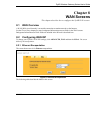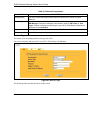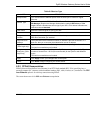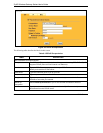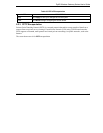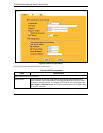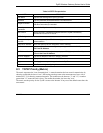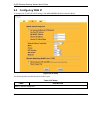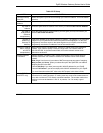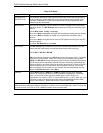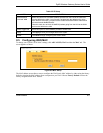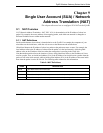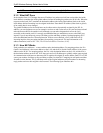
ZyAIR Wireless Gateway Series User’s Guide
WAN Screens
8-9
Table 8-5 IP Setup
LABEL DESCRIPTION
Get automatically
from ISP
Select this option If your ISP did not assign you a fixed IP address. This is the default
selection.
Use fixed IP
address
Select this option If the ISP assigned a fixed IP address.
My WAN IP
Address
Enter the ZyAIR WAN IP address in this field if you selected Use Fixed IP Address.
My WAN IP
Subnet Mask
(Ethernet
encapsulation)
Enter the ZyAIR WAN IP subnet mask (if your ISP gave you one) in this field if you
selected Use Fixed IP Address.
Remote IP
Address (or
Gateway IP
Address)
Type the IP address of the remote network or gateway. The gateway is an immediate
neighbor of your ZyAIR that will forward the packet to the destination. On the LAN,
the gateway must be a router on the same segment as your ZyAIR; over the WAN,
the gateway must be the IP address of one of the remote nodes.
Remote IP Subnet
Mask (PPPoE
and PPTP
encapsulation)
When using a LAN to LAN application, type the IP subnet mask of the destination
network. If you need to specify a route to a single host, use a subnet mask of
255.255.255.255, in the subnet mask field, to force the network number to be
identical to the host ID.
Network Address
Translation
Network Address Translation (NAT) allows the translation of an Internet protocol
address used within one network to a different IP address known within another
network.
SUA (Single User Account) is a subset of NAT that supports two types of mapping:
Many-to-One and Server. When you select this option the ZyAIR will use Address
Mapping Set 255 in the SMT.
Choose SUA Only if you have just one public WAN IP address for your ZyAIR.
Choose Full Feature if you have multiple public WAN IP addresses for your ZyAIR.
For more information about NAT refer to the NAT chapter in this User's Guide.
Metric (PPPoE
and PPTP only)
Type a number that approximates the cost for this link. Metric represents the "cost" of
transmission for routing purposes. IP routing uses hop count as the measurement of
cost, with a minimum of 1 for directly connected networks. The number need not be
precise, but it must be between 1 and 15. In practice, 2 or 3 is usually a good
number.



